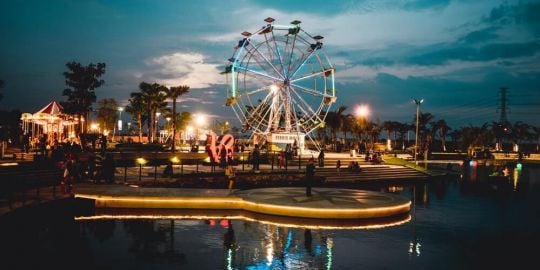About Nepal in General
Nepal, once a Kingdom and now, since April 2008, a Federal Democratic Republic, is a tiny country between its giant neighbors China (Tibetan Autonomous Region) in the north and the entire subcontinent of BHARAT, which is the actual and lesser known internal administrative name of the “Federal Union States of India” to the south.
Nepal is 147,181 square-kilometers in size, of which only half is suitable for human inhabitance. That makes Nepal's living space only two times larger than the Netherlands and it is equally crowded. The Netherlands, with 14 million citizens, has the densest population in Europe with approximately 103 people per square kilometer. Therefore the Netherlands and Nepal not only sit next to each other in the United Nations Assembly but also shares the same density in population with Nepal, who now has almost 28 million living souls. Luckily the population growth rate is slowly stabilizing here, just like the Netherlands stabilized over 45 years ago. In Nepal this is thanks to a gradually better road access from remote areas to the more advanced cities with their superior health care facilities.
A statistically well known fact is that a people who can keep their children healthy and alive do not increase their birth rate any more. Better maternity care nationwide, fully financed by UNICEF, has slowly reached the most remote corners of the country has been successful for almost a decade.
A few other dedicated International NGO's such as the many Nepalese field workers of the joint Spanish-British Rural Development Organization ACTION AID, have been working in a very low-profile manner for a very long period of time.
Officially the government administrators count only about 25.5 million citizens but this number is certainly not true, as UNICEF has counted over three million people who have neither citizenship-certificates, nor a fixed place to stay that they can call their own home and property. Some are still nomads in the high mountain valleys and ranges, and they move around with their cattle in summer and stay put in makeshift winter quarters. Others are forest scavengers and hunter- communities and then there are countless illiterate slum dwellers with many small children who are unregistered with no address, no exact knowledge about where their parents or grandparents came from or where the heck in this country they were born.
This is Nepal's reality today: still no where near being a modern organized society.
The Government of India has no records at all about how many Nepalese live and work inside of Bharat, because Nepalese are free to cross in and out. The border between India is open with no visa required for Nepalese who desire to come for a job. Vice versa any Indian citizen can cross into Nepal without limitation or visa required.
There may even be an other one-and half million or so Nepalese living down there as 'seasonal workers' How can a government keep track on people who are always absent from any national census? They would not come 'home' to be counted, because they simply don't know when and where such a counting takes place.
Kathmandu is the capital of Nepal and historically recorded as a city and trade center between Tibet and India as early as 2600 years ago! Inside the dense and highly polluted city that is quickly becoming even more dense with building construction, an estimated 1.1 million people now live. The official count of 823,000 inhabitants is no longer correct, as the city has been overrun by internal refugees that came during the Maoist insurgency. Most of them have no intention of going back to their remote and underdeveloped dwellings that have most likely been destroyed during the 10-year long insurgency war.
Why should they ever go back? The have seen the riches of the capital city and they have the dream to let at least their children have a chance to get a better life..
Geographically as well as geologically Nepal is a world of its own. To the north the mighty Himalayas make for a natural weather boundary that allows an almost isolated flora and fauna of its own. One can travel through three different climate zones within a day by jeep or truck'¦or with a helicopter within just three-quarters of an hour: From arctic cold down to a hot climate that reaches a noon time temperature that is found only in the African Sahara. And so also, the very rich flora and fauna of the country is arranged in rapidly changing lines of miraculous wonder.
The visitors can observe the legendary high pastures and watch to a rough climate adapted yaks and mountain sheep eating grass above their heads and rhinos, elephants and tigers walking through dense jungle and grass lands at their feet.
All this can be seen in a natural habitat within one day for those who can afford to hire an air-conditioned jeep with a skilled Nepalese driver for no lesser than 300 U.S. dollars per day, or can charter a helicopter for a whopping sum of 1800 U.S. dollars per hour.
The superlatives do not end here. Seven of the highest mountains of the world, which of course are topped by the 8,848 meter high Mt. Everest, tower among the awesome and picturesque mountain range, a range that extends from the far western corner to the far eastern corner of the country like a huge panorama picture of gigantic size, when one approaches Nepal by airplane from the Indian plains.
Forty percent of Nepal reaches up to an altitude of 3,000 meters but is not at all covered with snow like the Alps in Europe. The upper tree boundary in Nepal is at an altitude that varies between 4,000 and 4,500 meters high and is evergreen due to huge pine forests. The lowest lands are the southern Terai plains at only 70 meters above sea level.
It is the fertile middle of Nepal that attracts the foreign trekkers; there one can trek into the mild Mediterranean climate like the hilly region with orange groves and sweet smelling fields of ripening rice. From there one enters the trekking paths into the beautiful subtropical foothill forests that lead around the Annapurna range, crossing the legendary Thorung La pass of 5,462 meters high, to have a peek into the dry and bare Tibetan Plateau that starts right behind it.
There are also plenty of cultural sights all over Nepal for the tourists. Here one finds Hindu temples as old as 2,000 years, Buddhist shrines and monasteries and Lumbini, the recently confirmed genuine birth place of Gautam the Buddha (formerly claimed by India near the city of Bhotgaya).
The tourist can also visit ancient palaces of long-vanished small kingdoms and principalities that date before the King of Gorkha Narayan Shah conquered Kathmandu valley to create the boundaries of today's Nepal. He managed this easily and without much resistance from any local people, because he was supported by the sheer force of then modern art of cavalry that was developed a millennium before by the warriors of the Rajput Kingdom in North western India. The entire country is a world heritage site!
Last but not least, the country attracts mountain climbers from all over the world. This ever since Edmond Hillary uttered his 'famous sentence' when asked 'Why do you want to conquer the holy Sagarmatha?' and he answered: 'Because it is there!'
Mount Everest is a holy mountain.
It has three distinguished names to offer for those who wonder why it has the name of a British Indian Colonial Survey officer and cartographer with the name Lord Everest, who never laid eyes on it.
There is the most ancient name that goes right back to the Rig Vedas, the oldest known scriptures on earth that were written millennia ago and claimed to be over 4,000 years old. They mention a mountain so high and mighty that it had to be the throne of a God. Whoever would be that strong to go up there and sit down to watch the world? Hanuman the mighty ape god, of course, so the first name of Mount Everest was 'Hanumante Hyum Mahal,' the great Ape God Hanuman's Palace of Snow"! There are a bunch of so called Indian Crypto-Zoologists who believe that the Ape God Hanuman was actually a Yeti and that the yetis were involved in the great ancient war for justice, the 7,000 page long story of the Maha-Bharata!
The next name in line is probably the Sanskrit name of Everest that was given by the High Priests at the court of legendary King Ram of Maha-Bharat ( The Empire of Greater Hindia) That name was Sagarmatha'¦the holy mother of all mountains. When the Sherpas entered Nepal by trekking for ages as nomads down from eastern Mongolia and entered the mountains from the Tibetan plateau in search of potatoes, they arrived at the foot of Mount Everest and settled down only an astonishing 800 years ago. They were the last ethnic tribe to arrive in Nepal amongst over 200 other tribes and clans that wriggled into Nepal from all directions imaginable for over 3,000 years.
Potatoes'¦.? Lang ? (an ancient Tibetan word for potatoes) How can this be? Langtang ? The potato valley? North of Kathmandu and behind the first high range of the Naja Kanga peak and over the Ganja la pass of 5,200 meters is the place where the Sherpas of Helambu, who are relatives of the ones in Sagarmatha National Park Solo Khubu, had found their tiny nutritious Himalayan dark red variety of potato that the cultivate and still serve to trekkers! Only today they call them alu and no more lang! The best of the best and tastiest alu can be found in a Sherpa village called Talu, about 2 kilometers down from the place were the lost trekker James Scott was found alive in 1991.
The Chinese archeologists found potatoes in cemeteries and tombs that are 3,000 years old. Could it be that Mongolian tribes brought the potato to the Americas en route Bering straights ? Or was the potato just a common crop in all the mountains of our planet? That remains one of the questions here in Nepal'¦a land of magic and mystery!
The Sherpa name for Everest is Cholomungma by the way! Mother Goddess of the Universe!









